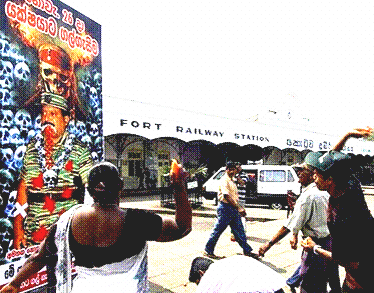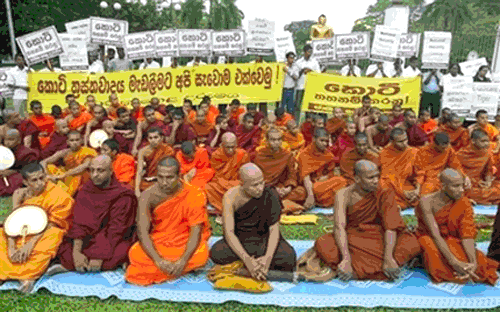TAMIL NATIONAL FORUM
Selected Writings -
Fr.
Chandiravarman Sinnathurai
Transforming Dialectics into Dialogue -
A Humanising Concept
16 December 2006

THE ABOVE PHOTO reveals the venom of demonisation of the
so-called enemy � the Tamils. In the heart of the Sri Lankan metropolis; a
spitting-distance from the Colonial Central Railway Station, the distorted
billboard image of the Tamil leader
Mr Prabaharan is portrayed as a monster-Dracula surrounded by skulls of
heroes who have given their young lives for liberation. A mocking caricature of
the Tamil struggle this is.
The Sinhala people will have no hesitation to vent spleen by throwing tomatoes
at the image. Not excluding of course, one would think, of spitting at the image
conjoined with racist abuse. They must be muttering the ancient derogatory
phrase �Para Demelu� � a catchphrase for belittling the Tamils.
The picture-perfect evidence exposes the hold of the state propaganda on the
minds of the masses. It is no doubt having the intended effect on the
psychological dynamics of the Sri Lankan society. Invoking the
racist
ideological atrocities of Mahavamasa and viewing Tamils as �traditional
adversaries� are a volatile lethal mix and a mesmerizing violent occupation of
the Sinhala Buddhist polity. As a consequence the Tamils have faced
persecution,
victimisation, death-squads, mob violence and serial pogroms. The Mahavamsa
�text of persecution� have ignited emotions and acted simply as a catalyst to
conflict. Starting from the top:
a) the presidency ─ guardian of the Buddhist nation;
b) the system of governance ─ protecting and fostering state religion �
Buddhism;
c) the armed forces ─ generally viewed as chauvinistic death squads by
Tamils;
d) the legal machinery and to all the encompassing government departments
and organisations are inherently institutionally racist.
Christian theologians would see such a system as a structural
sin. The bias against the Tamils � to put it mildly is, a historical fact[1].
Buddhist clergy has not helped in this regard; Buddhism is singularly a Sinhala
Theravada preserve and therefore the saffron-robed politico monks are
pre-eminent propagators of the Buddha Sasana consciousness. Put it simply, such
a rationale among other racist ideas, locate its core values and ideological
components within the following tripartite formula:
1) Dhammadipa �
A spatial concept of the island giving historical priority to Sinhala race,
Sinhala language, and Therevada Buddhism. Sri Lanka is seen solely as a
hallowed Buddhist territory: One race, one language (Sinhala pamanak �
Sinhala only) and one religion. Hence the idea of
Sri Lanka being a pluralistic society is anathema to the majoritarian system.
This is something that the West has chosen to ignore.

Demonopolisation of a single religion (i.e. Theravada Buddhism) and
promotion of pluralism has not been seen as the fundamental building block
of the peace talk�s agenda. In order to overcome this roadblock to peace,
the state of
Tamil Eelam is envisioned, as one European academician puts it �to be
constituted by history, territory and language but not by one specific
religion.�
2) Bhumiputra: Only the Buddhist Sinhalas are seen as the sole sons of the
soil. Hence the fiction of a united country and a unitary constitution is
all part of a bigger myth. Within a Bhumiputra concept none other than the
Sinhalas have claim to the �hallowed� land. Hence,
secret
colonisation of the Tamil homeland, militarised encroachment, and
slow-genocide [2] are all-natural propulsion
of such an ideology.
One must be reminded that Sri Lanka was not a one-nation state
until it was established as a unitary state under the British in 1833.
The prior Colonisers, the Portuguese and the Dutch ruled it as a divided
colony. The Tamils had their own Kingdom.
3) Eka Chatta: Devolution as suggested by many pundits is far from
orthopraxy. In other words it is utterly unworkable within the Mahavamsa
orthodoxy. Centralised power is the only possibility of survival for such an
ideology. ( Ref: Schalk: Articles 9 and 18 of the Constitution of Sri Lanka
as Obstacles to peace. Uppsala/1990).
Dialogue
Dialogue is absolutely essential for conflict resolution. However, prior to
engaging in any open and frank dialogue, one should be mindful to dislodge
certain myths. And that is fundamental, only if the dialogue is aimed at
transforming conflict, in order to create conditions for peace, justice,
good governance, equity, empowerment, human rights and civil liberties.
Dialogue of the deaf is not conducive to positive results. When one listens
to the other � which can be a painful experience, then slowly doors begin to
open, walls begin to crumble, and the demonising fog begins to shift as one
begins to see eye-to-eye the humanity of the other.
"We are not chauvinists. Neither are we lovers of
violence enchanted with war. We do not regard the Sinhala people as our
opponents or as our enemies. We recognise the Sinhala nation. We accord
a place of dignity for the culture and heritage of the Sinhala people.
We have no desire to interfere in any way with the national life of the
Sinhala people or with their freedom and independence. We, the Tamil
people, desire to live in our own historic homeland as an independent
nation, in peace, in freedom and with dignity."
Velupillai Prabaharan
Mistakes
Peace study scholars, negotiation practitioners and conflict resolution
facilitators have identified the following three small mistakes that can be
big hindrance to Dialogue:
1) There is a general assumption that all conflicts are based on
misunderstandings that there is always blame on both sides. There is no
evidence for believing that this is always the case. It is really an
assumption. It is an unfounded assumption that could only be made by people
who do not suffer under injustice and oppression or who do not really
appreciate the sinfulness and evil of what is happening.
2) There is an argument that a person can be neutral in all cases of
conflict. In fact neutrality is not always possible, and in cases of
conflict due to injustice and oppression, neutrality is totally impossible.
If we do not take sides with the oppressed, then we are, albeit
unintentionally, taking sides with the oppressor, because it enables the
status quo to be maintained; it hides the true nature of the conflict, keeps
the oppressed quiet and passive without justice and it brings about a
pseudo-peace without justice. The injustice continues and everybody is made
to feel that the injustice does not matter because the tension and conflict
have been reduced.
3) There is a commonly held view that one should always seek harmony and a
�middle way� in every dispute (especially if you happen to be Christian). It
assumes that tension and conflict are worse evils than injustice and
oppression. This again is a false supposition based upon a lack of
compassion who suffer under oppression. Such a view supports reconciliation
only to justify a form of escapism from the realities of injustice and
conflict. [Jim Stutzman and Carolyn Schrock-Shenk: � Skills for
Conflict Transformation Lecture Notes.]
In the final analysis, the insistent pursuit of an illusory neutrality in
every conflict is a way of siding with the oppressor.
Conclusion
 Sri
Lanka has to take seriously the responsibility of building peace with Eelam
Tamils and avoid playing �Tom and Jerry�. Its implicitly clear that military
solution is not the answer. The International community ought to put in
place an arms embargo to Sri Lanka if they are genuinely concerned of the
human rights record. It is tragic that only the opposite has happened
thus far while over 700,000 innocent Tamils are facing economic, food and
medicine embargo in the North-East Tamil territory even as we write. While
on the other side, Sri Lanka�s war economy has created many mushrooming war
millionaires! Sri
Lanka has to take seriously the responsibility of building peace with Eelam
Tamils and avoid playing �Tom and Jerry�. Its implicitly clear that military
solution is not the answer. The International community ought to put in
place an arms embargo to Sri Lanka if they are genuinely concerned of the
human rights record. It is tragic that only the opposite has happened
thus far while over 700,000 innocent Tamils are facing economic, food and
medicine embargo in the North-East Tamil territory even as we write. While
on the other side, Sri Lanka�s war economy has created many mushrooming war
millionaires!
Any reasonable
Dialogue has to first consider overcoming the foundational problem: the
above mentioned tripartite formula: Dhammadipa, Bhumiputra, Eka Chatta.
Without that fundamental change, all else will be cosmetic and farcical.
Dehumanisation and demonisation of Eelam Tamils will not solve one iota of
the crisis.
______________________
Footnotes:
[1]
http://www.tamilnation.org/conferences/cnfCA99/avis.html
[2]
http://www.tamilnation.org/saty/060902chargeisgenocide.htm
|